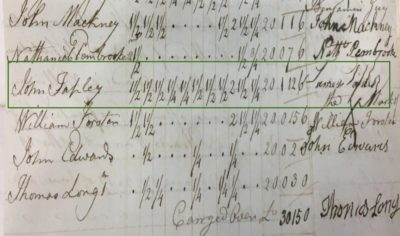James Tapley
Crown Court
Jews Harp Alley
Occupation: Mariner
James Tapley was born in Folkestone in 1772. He came from a family of mariners and it is as a mariner that he found employment in Deal’s Naval Dockyard. On the 28th January 1801, he married Ann Wilkins of Deal at St. Leonards Church. They settled in Crown Court and this is where all their eleven children were born and sadly where six of them died, all before their fourth birthdays.
 Dock-yard
Dock-yard
This is the time of the Napoleonic Wars and in 1803, two Acts of Parliament were passed requiring each county to raise a quota of men to serve in the army should England be invaded. Deal’s records survive and are known as the 1803 Lieutenancy Papers . The first Act was called ‘The Army of Reserve Act’, which wasn’t successful, partly because it relied on the Constables of the parish drawing up a list of men who could be balloted to serve and substitutes could be made. The second act ‘The Levee en Masse’ required each parish to return a list of ALL men in the parish between the ages of 17 and 55 including their suitability for military service. James is registered on both of these as working in the Dockyard and as a volunteer on the ‘Prince of Wales Gunboat’. James continued to be employed by Dockyard and on visiting The National Archives I found him in the ‘Deal Pay Lists’ and the ‘Extra List and Extra Deal’ records there. On the September 1802 ‘Extra List’ I noted an error. James’ name had been incorrectly written as ‘John Tapley’! I wonder if he noticed this at the time, even if he did he still signed for his pay in his scrawly hand.
The ‘Pay Lists’ describe the type of work given to the ‘Extra Labourers’ in each given month. These ‘labourers’ are listed by name and the time that they have worked is noted down in half days or part of that. The ‘Extra Lists and Extra Deal’ are duplicates of the ‘Pay List’ but it is on this list that each hired ‘labourer’ signs to acknowledge that he has received his pay.
Tapley Boatmen
In the Parish Rates book for Deal for 1830 we find James still living in Crown Court but by the 1841 Census, he and his family had moved into Jews Harp Alley where James and all his sons are recorded as Boatmen. They probably fished as well as ‘hovelling’, that is ferrying goods, people and mail to and from the many ships anchored off the shore and also salvaging cargoes from wrecks and in an age where there were many ships along the coast they would also offer assistance to those who needed help or even, as was sometimes needed, rescuing them.
Pilotage Acts
The new Pilotage Acts passed from 1808 onwards, meant that a Pilot’s cutter rather than Boatmen in their boats could ferry a Pilot out to board a vessel so he could guide it along the coast. Restrictions on those who could Pilot a vessel were also made so by 1833, even if a Licensed Boatman was acting as a Pilot, and then a Pilot came onboard to take over, that Pilot could take ALL the fee and the Boatmen would receive nothing. These things just added to the hardships being suffered by the Boatmen at that time and so it is that James and his sons are listed alongside their fellow Boatmen in a Select Committee Report.
‘Report from the Select Committee on Cinque-Port Pilots’
The report was ordered by the House of Commons after seven Deal boatmen, on behalf of their peers petitioned Trinity House regarding the difficulties being faced by the boatmen. Evidence was requested and given by the boatmen and other agencies proving the hardships that the boatmen and their families faced. Edward Darby a ships agent’s clerk stated it was “deplorable” where the men “…have no fires to sit by …”.
The end of the wars with France and the introduction of chain instead of hempen anchor cables were recognised as major factors in the decline of employment for the Deal boatmen. Hempen cables often came apart under stress. They were insured with the anchors & the boatmen would be paid for “rescuing” vessels who were foundering in rough weather due to losing their anchor.
 Merchant Seamen’s Register
Merchant Seamen’s Register
James and his eldest son John appear on the Merchant Seamen’s Register of 1835. This states that they both were then registered with the vessel ‘Po’ and both had certificates of competency or service.
James Tapley’s Children
By the time the 1841 census was taken James’s surviving daughters had married. Pleasant, who had married William Trott was also living in Jews Harp Alley with their family. Jane, who had married Edward Wilkins was living in South Drain (possibly now Hope Road) with their family. John his eldest son had married Elizabeth Makins and was living in South Street with their daughter. Thomas and Edward were still living at home in Jews Harp Alley. Edward remained in the Alley until the 1880s.